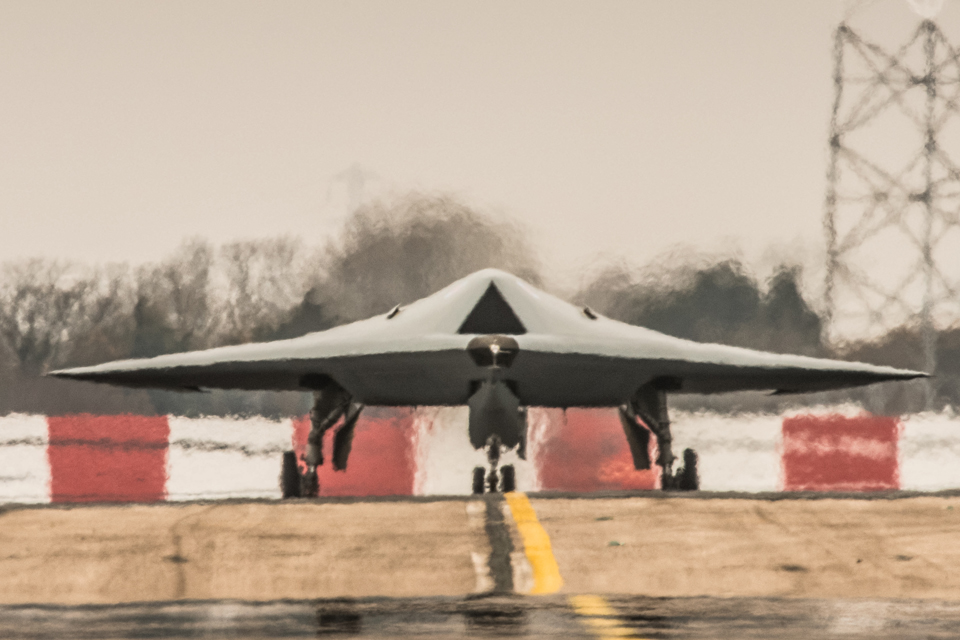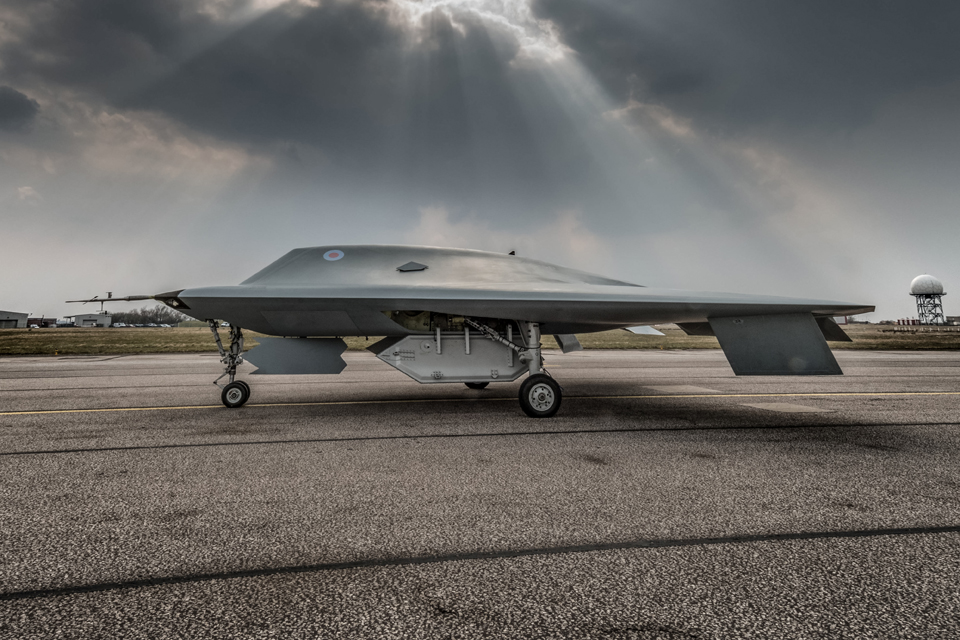13 août 2014 BAE Systems
A day in the life film of stealthy unmanned combat vehicle demonstrator Taranis, the most advanced aircraft ever built in the UK.
Video produced ahead of Farnborough International Airshow 2014.

13 août 2014 BAE Systems
A day in the life film of stealthy unmanned combat vehicle demonstrator Taranis, the most advanced aircraft ever built in the UK.
Video produced ahead of Farnborough International Airshow 2014.
15/07/2014 Par Véronique Guillermard – LeFigaro.fr
L'accord signé entre les ministres de la Défense français et britannique vise à lancer une étude de faisabilité d'un démonstrateur de drone de combat. Elle est confiée à Dassault Aviation et à BAE Systems qui se partagent un budget de 150 millions d'euros.
La coopération franco-britannique, inscrite au cœur des traités militaires de Lancaster House en 2010, franchit une nouvelle étape. Mardi 15 juillet, Paris et Londres ont officialisé leur intention - déclarée lors du sommet de Brize-Norton fin janvier 2014 - d'assurer l'avenir de l'aviation de combat européenne.
Les ministres de la Défense Jean-Yves Le Drian et Philip Hammond (nommé mardi aux Affaires étrangères dans le nouveau gouvernement britannique) ont signé, au Salon aéronautique de Farnborough, des accords qui «permettent l'engagement immédiat d'importants programmes de défense conduits en coopération entre les deux pays».
Au cœur de ces accords, le coup d'envoi d'une étude de faisabilité visant à préparer le lancement d'un programme de démonstrateur technologique de Système de combat aérien du futur (FCAS). L'étude est dotée d'un budget de 150 millions d'euros financés à parité par les deux gouvernements. Elle est confiée aux deux industriels compétents de chaque pays: le français Dassault Aviation* et le britannique BAE Systems ainsi que leurs partenaires respectifs Thales et Snecma côté français; Selex et Rolls-Royce, côté britannique. L'étude doit durer deux ans. Les deux équipes impliquant plusieurs centaines de salariés renforceront leurs échanges.
En 2016, au vu des résultats de cette phase préparatoire à la définition de ce que pourrait être un système d'aviation de combat du futur, Paris et Londres devront décider d'aller plus loin. D'abord en lançant le développement d'un démonstrateur de drone de combat (UCAS), une des composantes du FCAS. Une phase qui pourrait s'étaler sur quatre ans. Puis, aux alentours de 2020, en engageant un programme opérationnel, l'objectif étant d'être prêt à livrer les premiers aéronefs à l'horizon 2030. Ces chasseurs du futur - drones, avions avec pilotes à bord voire appareils hybrides - succéderont aux avions de combat actuels, le Rafale et l'Eurofighter.
Mise en commun des compétences
Cet accord «constitue une opportunité historique pour la France et le Royaume-Uni de construire une industrie de défense souveraine sur le long terme», a estimé Jean-Yves Le Drian. «Cette coopération est essentielle» face «aux défis mondiaux de défense et de sécurité» auxquels l'Europe pourrait être confrontée, a déclaré Philip Hammond. En cette période d'extrême tension sur les finances publiques sur le Vieux Continent, Paris et Londres veulent partager l'effort financier et mettre en commun les compétences pour rester aux avant-postes. Cela alors que le reste du monde augmente ses dépenses militaires et que les menaces se démultiplient.
Les industriels se sont félicités de cette nouvelle avancée. L'étude de faisabilité «représente une étape clef dans notre partenariat et fournit une feuille de route commune pour la coopération entre nos deux sociétés, qui pourrait finalement conduire à un programme conjoint de Système de combat aérien du futur dans l'avenir», déclarent Éric Trappier, PDG de Dassault Aviation, et Ian king, directeur général de BAE Systems.
«Nous avons besoin de cet engagement politique de long terme, car, au-delà de notre situation de rivalité actuelle - avec le Rafale et l'Eurofighter -, nous avons la volonté, avec BAE Systems, de préparer les technologies qui seront utiles pour répondre aux besoins de l'aviation de combat du futur», insiste Éric Trappier. L'étude «va s'appuyer sur le succès de programmes nationaux existants tels que nEUROn en France et Taranis au Royaume-Uni», précisent encore les deux groupes.
Satellite imagery acquired by DigitalGlobe appears to show the BAE-built Taranis stealth UCAV at Australia’s RAAF Woomera Airfield.
April 5, 2014 offiziere.ch
BAE Systems, a British defense and aerospace company, revealed earlier in February that the Taranis unmanned combat air vehicle demonstrator successfully completed its maiden flight at an undisclosed test location in Australia back in August.
Read more
Picture: Chris Ryding, BAE Systems
It has been revealed that the Taranis unmanned combat air vehicle surpassed all expectations during its first flight trials. The most advanced aircraft ever built by British engineers made its maiden flight at an undisclosed test range on Saturday 10 August 2013 and, under the control of a human operator, is capable of undertaking sustained surveillance, marking targets, gathering intelligence, deterring adversaries and carrying out strikes in hostile territory. Click here to read more.
5 February 2014 Ministry of Defence and Defence Equipment and Support
MOD and BAE Systems have revealed that the Taranis unmanned combat air vehicle surpassed all expectations during its first flight trials.
The most advanced aircraft ever built by British engineers made its maiden flight at an undisclosed test range on Saturday 10 August 2013 under the command of BAE Systems test pilot Bob Fraser.
MOD has today revealed that the demonstrator aircraft made a perfect take-off, rotation, ‘climb-out’ and landing on its 15-minute first flight. A number of flights took place last year, of up to 1 hour in duration and at a variety of altitudes and speeds.
The Taranis demonstrator is the result of 1.5 million man-hours of work by the UK’s leading scientists, aerodynamicists and systems engineers from 250 UK companies.
The aircraft has been designed to demonstrate the UK’s ability to create an unmanned air system which, under the control of a human operator, is capable of undertaking sustained surveillance, marking targets, gathering intelligence, deterring adversaries and carrying out strikes in hostile territory.
The findings from the aircraft’s flights prove that the UK has developed a significant lead in understanding unmanned aircraft which can strike with precision over a long range whilst remaining undetected.

The technological advances made through Taranis will also help MOD and the Royal Air Force make decisions on the future mix of manned and unmanned fast jet aircraft and how they will operate together in a safe and effective manner for the UK’s defences.
Costing £185 million and funded jointly by MOD and UK industry, the Taranis demonstrator aircraft was formally unveiled in July 2010, but only a very limited number of scientists and engineers have ever been given full access to the top secret aircraft.
Initial ‘power-up’ or ground testing commenced later in 2010 at BAE Systems’ military aircraft factory in Warton, Lancashire, followed by a comprehensive and highly detailed programme of pre-first-flight milestones.
These included unmanned pilot training, radar cross-section measurements, ground station system integration and, in April 2013, taxi trials on the runway at Warton.
The aircraft and its ground station were then shipped from Warton to the test-range before being reassembled and undergoing systems and diagnostics checks. Taranis then made a number of high speed taxi tests in July before its maiden flight in August 2013.

Minister for Defence Equipment, Support and Technology, Philip Dunne, said:
Taranis is providing vital insights that will help shape future capabilities for our armed forces in coming decades. Its advanced technology is testament to the UK’s world-leading engineering skills that keep Britain at the cutting-edge of defence.
Commenting on behalf of the industry team, Nigel Whitehead, Group Managing Director of BAE Systems, added:
The first flight of Taranis represents a major landmark for UK aviation. The demonstrator is the most advanced air system ever conceived, designed and built in the UK.
It truly represents an evolution of everything that has come before it. This milestone confirms the UK’s leading position as a centre for engineering excellence and innovation.
About the size of a BAE Systems Hawk aircraft, Taranis has been designed and built by BAE Systems, Rolls-Royce, the systems division of GE Aviation (formerly Smiths Aerospace) and QinetiQ, working alongside MOD military staff and scientists.
In addition to prime contracting the project, BAE Systems led on many elements of the Taranis technology demonstrator, including the low observability, systems integration, control infrastructure and full autonomy elements (in partnership with QinetiQ).
November 10, 2013 by martin – Think Defence
It seems that the long awaited first flight of Taranis in Australia has already taken place but been kept a under wraps. I would love to know more about this aircraft and many of the outlandish claims in the media including that it is super sonic with a 2,000 – 4,000 mile range and one of the lowest Radar Cross Sections ever recorded. But the men at the ministry are giving nothing away for once.
Parliamentary Documents Reveal Beginning Of Taranis Test Flights
28.10.2013 Helen Chachaty - journal-aviation.com
L’information a été dévoilée par le Parlement britannique dans un rapport publié le 25 octobre : le drone Taranis développé par BAE Systems a effectué des essais en vol au cours de l’année 2013.
Ces essais ont eu lieu en Australie, comme l’avait révélé le quotidien britannique The Telegraph en janvier 2013.
Le démonstrateur de drone de combat avait été présenté pour la première fois en juillet 2010 et les essais au sol avaient débuté dans la foulée.
Pesant environ huit tonnes et possédant des dimensions proches de la taille d’un Hawk, le Taranis est resté discret depuis ses débuts en 2006. Le programme est actuellement estimé à environ 180 millions de livres.